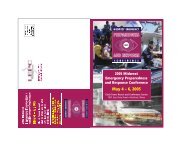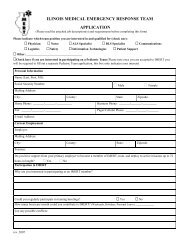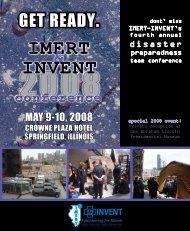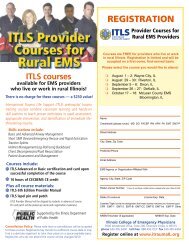Summit Invitation - The Illinois Medical Emergency Response Team
Summit Invitation - The Illinois Medical Emergency Response Team
Summit Invitation - The Illinois Medical Emergency Response Team
You also want an ePaper? Increase the reach of your titles
YUMPU automatically turns print PDFs into web optimized ePapers that Google loves.
Keynote SpeakersOPENING SESSION<strong>Team</strong>work in Crisis – <strong>The</strong> Story of Flight 232Captain Alfred C. “Al” HaynesOn July 19, 1989, United Airlines flight 232 departed Denver at 2:09 p.m. and climbed to 37,000 feet. At 3:16p.m. the flight notified Minneapolis Air Traffic Control that the No. Two engine had failed and the aircraft wasmarginally controllable. Captain Al Haynes was the pilot of that infamous flight.That 184 people survived the crash landing of United 232 can be attributed to five main factors: luck, communication,preparation, execution, and cooperation. Luck involved the fact that the airplane remained flyable,and the location, weather, and time of day were favorable. Quick and total response by air traffic control, cockpitand cabin crew training, proper inter-communications training among ground units, and proper use of availablefacilities contributed to the communications factor. A live drill leading to improvements and better planning fordisasters coupled with thorough training of cockpit and cabin crews helped prepare everyone for this seeminglyimpossible task. Everyone responded as his or her training dictated and required a total team effort coupledwith complete cooperation from every agency involved as well as the general public. <strong>The</strong>se factors allowedwhat appeared to be a non-survivable accident to be one in which a large percentage of those aboard survived.Haynes was born in Paris, Texas, and raised in Dallas. He attended Texas A&M College before joining theNaval Aviation Cadet Training program in 1952. He was released from the service in 1956 after serving asa Marine aviator. He joined United Airlines that year as a flight engineer and served in that capacity until hispromotion to first officer in 1963. He flew the DC-6, DC-7, DC-8, Boeing 727, and DC-10. Haynes was promotedto captain in 1985 and flew the Boeing 727 and DC-10 up to his retirement in August 1991, accumulatingmore than 27,000 hours of flight time.Haynes has been a volunteer umpire for Little League Baseball for the past 36 years and a stadium announcerfor high school football for the past 30 years.LUNCHEON SESSIONDisaster Mythology – What Really Happens at the Worst of TimesAmanda RipleyIn 2005, Amanda Ripley covered hurricanes Katrina and Rita from New Orleans helping TIME win two nationalmagazine awards. Two years earlier, she covered the European heat wave, which killed an estimated 50,000people, from TIME’s Paris bureau. On Sept. 11, 2001, Ripley was in New York City. That day and for years afterwards,she wrote extensively about the attacks, the victims and the recovery of the city and the survivors. Todiscuss her stories, she has appeared on NBC’s “Today” Show, ABC News, CNN, FOX News, C-Span, CNBC,MSNBC, NPR and dozens of international, national and local radio shows. What makes Ripley’s work unusualis that she doesn’t just explain what happened, she obsessively investigates why people do what they do, andhow we can do better, combining science and practical lessons with literary storytelling.Ripley also has been integrally involved in TIME’s Person of the Year cover stories. She did extensive reportingfor the 2001 Person of the Year profile of Rudy Giuliani and was the lead writer and reporter for TIME’s2002 People of the Year cover story on the FBI, WorldCom and Enron whistleblowers. In 2004, she traveled toIndia and Bangladesh to write the People of the Year cover profile of Bill and Melinda Gates.Before joining TIME, Ripley covered the D.C. court system for Washington City Paper and reported onCapitol Hill for Congressional Quarterly. She has contributed to the New York Times Magazine, the WashingtonMonthly and Time Out. She received a Bachelor of Arts in Government from Cornell University. She hasreceived awards from the Society of Professional Journalists, the Newswomen’s Club of New York and theWashington Monthly, among others, and she is a two-time Livingston Award finalist. She currently covers riskand human behavior for TIME and other publications in Washington, DC.Ripley is also the author of the popular book, “<strong>The</strong> Unthinkable: Who Survives When Disaster Strikes – andWhy,” which is now being published in 15 countries, from the United Kingdom to China to Brazil.








